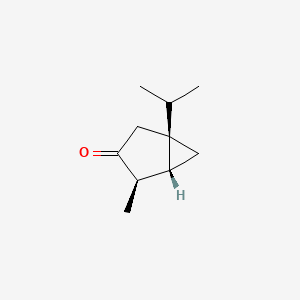|
|
|
|
pmid:18511141
|
| Sapra B et al. |
Percutaneous permeation enhancement by terpenes: mechanistic view. |
2008 |
AAPS J |
pmid:18446512
|
| Lachenmeier DW |
[Thujone-attributable effects of absinthe are only an urban legend--toxicology uncovers alcohol as real cause of absinthism]. |
2008 |
Med Monatsschr Pharm |
pmid:18429531
|
| Lachenmeier DW et al. |
Chemical composition of vintage preban absinthe with special reference to thujone, fenchone, pinocamphone, methanol, copper, and antimony concentrations. |
2008 |
J. Agric. Food Chem. |
pmid:18419128
|
|
|
|
|
pmid:18397765
|
|
|
|
|
pmid:18283947
|
| Cha JD et al. |
Chemical composition and antibacterial activity of essential oil from Artemisia feddei. |
2007 |
J. Microbiol. Biotechnol. |
pmid:18167456
|
| Bielenberg J |
[Thujone]. |
2007 |
Med Monatsschr Pharm |
pmid:17912872
|
| Lachenmeier DW and Nathan-Maister D |
Absinthe and tobacco--a new look at an old problem? (Comment on: Absinthe--is its history relevant for current public health?). |
2008 |
Int J Epidemiol |
pmid:17898026
|
| Gleiser RM and Zygadlo JA |
Insecticidal properties of essential oils from Lippia turbinata and Lippia polystachya (Verbenaceae) against Culex quinquefasciatus (Diptera: Culicidae). |
2007 |
Parasitol. Res. |
pmid:17616850
|
|
|
|
|
pmid:17506022
|
| Lachenmeier DW |
[Absinthe - history of dependence to thujone or to alcohol?]. |
2007 |
Fortschr Neurol Psychiatr |
pmid:17506021
|
| Raal A et al. |
Composition of the essential oil of Salvia officinalis L. from various European countries. |
2007 |
Nat. Prod. Res. |
pmid:17487611
|
| Lans C |
Ethnomedicines used in Trinidad and Tobago for reproductive problems. |
2007 |
J Ethnobiol Ethnomed |
pmid:17362507
|
| Mahattanatawee K et al. |
Comparison of three lychee cultivar odor profiles using gas chromatography-olfactometry and gas chromatography-sulfur detection. |
2007 |
J. Agric. Food Chem. |
pmid:17266328
|
|
|
|
|
pmid:17230311
|
|
|
|
|
pmid:17192005
|
| Orav A et al. |
Phytochemical analysis of the essential oil of Achillea millefolium L. from various European Countries. |
2006 |
Nat. Prod. Res. |
pmid:17127661
|
| Lachenmeier DW et al. |
Absinthe--a review. |
2006 |
Crit Rev Food Sci Nutr |
pmid:16891209
|
|
|
|
|
pmid:16814443
|
| Rekand T |
Absinthe, the nervous system and painting. |
2006 |
Int. Rev. Neurobiol. |
pmid:16730520
|
| Padosch SA et al. |
Absinthism: a fictitious 19th century syndrome with present impact. |
2006 |
Subst Abuse Treat Prev Policy |
pmid:16722551
|
| Adams JD and Garcia C |
Women's health among the Chumash. |
2006 |
Evid Based Complement Alternat Med |
pmid:16550233
|
| Bellavite P et al. |
Immunology and homeopathy. 2. Cells of the immune system and inflammation. |
2006 |
Evid Based Complement Alternat Med |
pmid:16550219
|
| Jiang Y et al. |
Radical intermediates in the catalytic oxidation of hydrocarbons by bacterial and human cytochrome P450 enzymes. |
2006 |
Biochemistry |
pmid:16401082
|
|
|
|
|
pmid:16366708
|
|
|
|
|
pmid:16278011
|
|
|
|
|
pmid:16190647
|
| Chiang LC et al. |
Antiviral activities of extracts and selected pure constituents of Ocimum basilicum. |
2005 |
Clin. Exp. Pharmacol. Physiol. |
pmid:16173941
|
| Bonkovsky HL et al. |
Porphyrogenic properties of the terpenes camphor, pinene, and thujone (with a note on historic implications for absinthe and the illness of Vincent van Gogh). |
1992 |
Biochem. Pharmacol. |
pmid:1610401
|
| Lachenmeier DW et al. |
Thujone--cause of absinthism? |
2006 |
Forensic Sci. Int. |
pmid:15896935
|
|
|
|
|
pmid:15635687
|
| Hall AC et al. |
Modulation of human GABAA and glycine receptor currents by menthol and related monoterpenoids. |
2004 |
Eur. J. Pharmacol. |
pmid:15588619
|
| Dettling A et al. |
Absinthe: attention performance and mood under the influence of thujone. |
2004 |
J. Stud. Alcohol |
pmid:15536765
|
| Umlauf D et al. |
Biosynthesis of the irregular monoterpene artemisia ketone, the sesquiterpene germacrene D and other isoprenoids in Tanacetum vulgare L. (Asteraceae). |
2004 |
Phytochemistry |
pmid:15381410
|
| He X and Ortiz de Montellano PR |
Alpha- and beta-thujone radical rearrangements and isomerizations. A new radical clock. |
2004 |
J. Org. Chem. |
pmid:15307740
|
| He X and de Montellano PR |
Radical rebound mechanism in cytochrome P-450-catalyzed hydroxylation of the multifaceted radical clocks alpha- and beta-thujone. |
2004 |
J. Biol. Chem. |
pmid:15258138
|
| Behrens M et al. |
The human taste receptor hTAS2R14 responds to a variety of different bitter compounds. |
2004 |
Biochem. Biophys. Res. Commun. |
pmid:15178431
|
|
|
|
|
pmid:15030239
|
| Deiml T et al. |
Alpha-thujone reduces 5-HT3 receptor activity by an effect on the agonist-reduced desensitization. |
2004 |
Neuropharmacology |
pmid:15002407
|
| Remberg P et al. |
Characteristics, clinical effect profile and tolerability of a nasal spray preparation of Artemisia abrotanum L. for allergic rhinitis. |
2004 |
Phytomedicine |
pmid:14971719
|
|
|
|
|
pmid:14659733
|
| Pitarokili D et al. |
Volatile metabolites from Salvia fruticosa as antifungal agents in soilborne pathogens. |
2003 |
J. Agric. Food Chem. |
pmid:12744657
|
|
|
|
|
pmid:12689680
|
|
|
|
|
pmid:12677536
|
| Santos-Gomes PC and Fernandes-Ferreira M |
Essential oils produced by in vitro shoots of sage (Salvia officinalis L.). |
2003 |
J. Agric. Food Chem. |
pmid:12670167
|
|
|
|
|
pmid:12624823
|
| Gambelunghe C and Melai P |
Absinthe: enjoying a new popularity among young people? |
2002 |
Forensic Sci. Int. |
pmid:12477641
|
|
|
|
|
pmid:12391564
|
| Holstege CP et al. |
Absinthe: return of the Green Fairy. |
2002 |
Semin Neurol |
pmid:12170397
|
